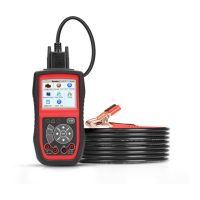
Do you have a question about the Autel Autolink AL539B and is the answer not in the manual?
| Storage Temperature | -20°C to 70°C (-4°F to 158°F) |
|---|---|
| Display | 2.8 inch color LCD |
| Operating Temperature | 0°C to 50°C |
| Supported Protocols | ISO9141 |
| Features | Live data |
| Compatibility | Works with most OBD II compliant vehicles |
| Connectivity | USB |
Explains the second generation of On-Board Diagnostics systems and their purpose.
Defines Diagnostic Trouble Codes, their structure, and purpose in identifying vehicle faults.
Details the standard location of the 16-cavity connector used for scan tool interface.
Describes Readiness Monitors, indicators of emissions component evaluation by the OBD II system.
Explains how OBD II systems indicate component testing completion and readiness status.
Provides definitions for key OBD II terms like PCM, MIL, DTC, and Enabling Criteria.
Introduces the OBD II communication protocol and describes diagnostic modes.
Provides a detailed overview of the scan tool's physical components and their functions.
Lists all items included with the scan tool package for different models.
Explains special characters used for navigating the scan tool interface.
Provides instructions on cleaning and care of the scan tool's keypad.
Details the methods for powering on the scan tool and charging its battery.
Explains how to search for definitions of Diagnostic Trouble Codes (DTCs) and code breaker information.
Guides users through adjusting settings like language, units, and beep preferences.
Specifies the types of vehicles and model years supported by the scan tool for OBD II diagnostics.
Offers solutions for common problems encountered while using the scan tool, such as linking errors.
Explains how to view data recorded from previous tests on the scan tool.
Details how to read stored, pending, and permanent Diagnostic Trouble Codes (DTCs).
Provides instructions on how to erase trouble codes and related data from the vehicle's computer.
Describes how to view and record live or real-time PID data from the vehicle's computer modules.
Explains how to view vehicle operating parameters captured when a DTC was detected.
Details how to check emission system readiness status for state inspections.
Explains how to retrieve and view O2 sensor monitor test results.
Guides users on retrieving and viewing test results for non-continuously monitored emission systems.
Describes how to initiate a leak test for the vehicle's EVAP system.
Explains how to retrieve vehicle identification and calibration data using Mode 9.
Details how to view module IDs and communication protocols for OBD2 modules in the vehicle.
Explains the purpose of the Ready Test function for emission test readiness.
Describes how to use the Ready Test function as a post-repair diagnostic tool.
Explains the meaning of LED indicators and audio tones used in the Ready Test function.
Describes the AUTO mode for circuit testing, which automatically selects functions based on circuit conditions.
Explains how to measure DC voltage with the scan tool.
Explains how to measure AC voltage with the scan tool.
Details how to check circuit continuity using the scan tool.
Explains how to test diodes and read their forward voltage drop.
Describes how to measure current in 0-20A and 0-200mA ranges.
Explains how to test the vehicle's starting system by measuring cranking voltage.
Guides users on testing the vehicle's charging system, including alternator and battery health.
Outlines the terms and conditions of the one-year limited warranty for the product.
Provides information on how to obtain service or contact customer support for the product.
